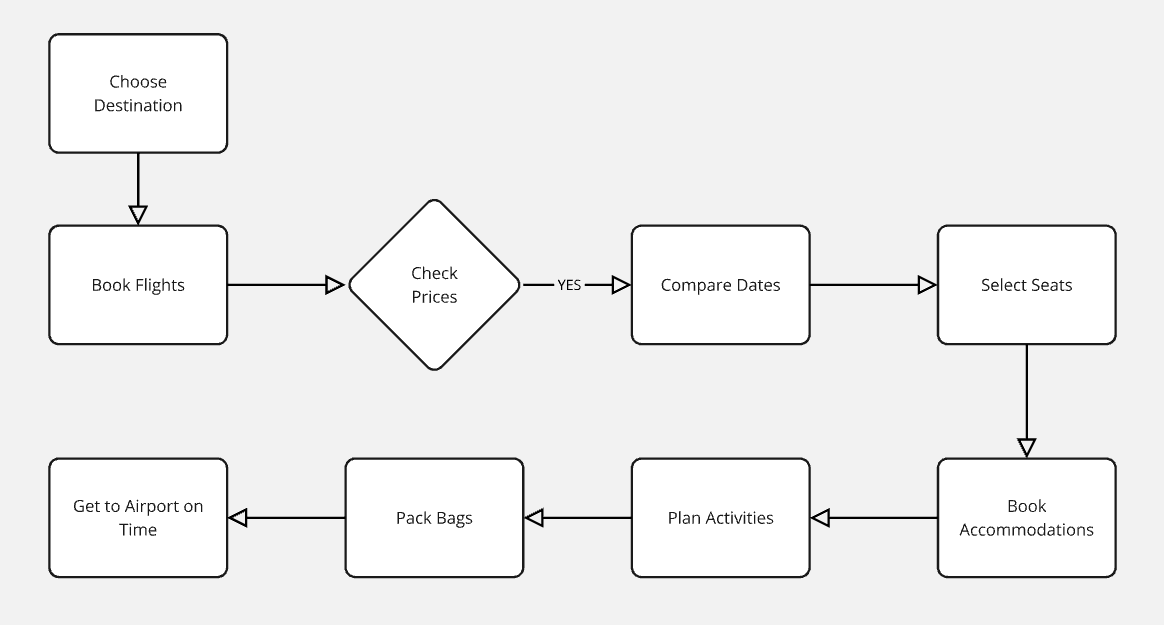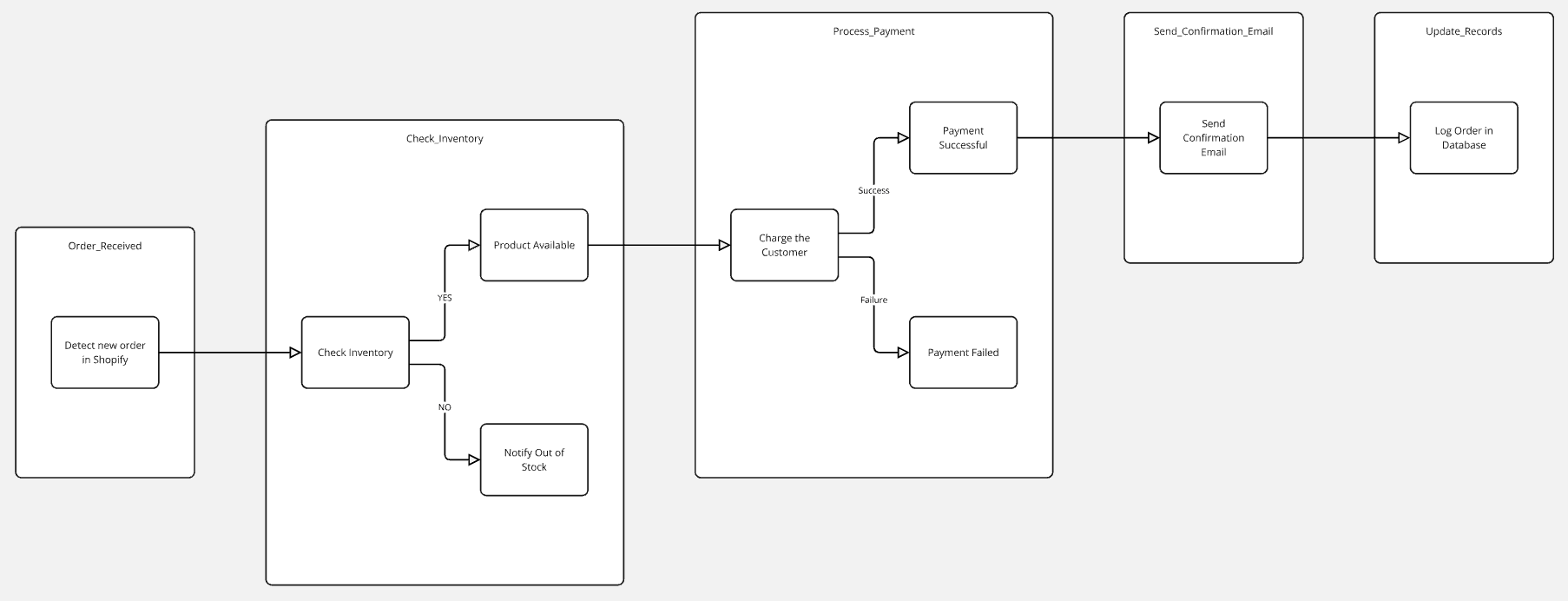The Non-Coder’s Guide to Algorithmic Thinking. Part 2
The Core Principles That Make Automation Work. Why Workflows Break (And How to Fix Them)
Ever wrestled with an automation that seemed to have a mind of its own?
Skipped steps? Wrong triggers? Refused to run altogether?
It’s frustrating - we’ve all been there. Most automation headaches aren’t tech issues. They’re logic issues.
Premature firing – Your workflow jumps the gun before the right conditions are met.
Missing links – A crucial step gets skipped, leaving your process incomplete.
Infinite loops – Something spins out of control, repeating endlessly
That’s why we’re diving into the four core principles of algorithmic thinking. Mastering these will help you structure workflows that work flawlessly.
Quick Recap from Part 1:
In the last issue, we unpacked algorithmic thinking and why it’s the missing piece to mastering automation. If you missed it, take a quick detour back - this guide will make a lot more sense afterward.
Now, let’s break down the four key skills that will take your automation game to the next level.
📌 Subscribe now to stay ahead - we’re building your automation expertise step by step!
Decomposition – Transforming Overwhelm into Actionable Steps
How many times you faced a complex task and thought, Where do I even begin?
That feeling of being overwhelmed is exactly why decomposition is the foundation of algorithmic thinking.
Big problems feel chaotic. Small problems feel solvable.
Decomposition forces you to break down daunting tasks into smaller, structured steps - making them easier to understand, automate, and troubleshoot.
Decomposition in Action: You’re Already Doing It
You use decomposition all the time, whether you realize it or not.
Take planning a vacation - you don’t just say, “Trip planned!” and expect everything to fall into place. You break it down into steps:
✔ Choose a destination
✔ Book flights and accommodations
✔ Plan activities
✔ Pack your bags
✔ Get to the airport on time
Each of these is a sub-task, and many can be broken down even further. “Book flights” might involve checking prices, comparing dates, and selecting seats.
This is decomposition in its purest form - taking an overwhelming goal and turning it into clear, actionable steps.
Decomposition in Automation: The Fix for Messy Workflows
Many people approach automation the wrong way:
❌ Trying to automate an entire, complex process in one massive, tangled workflow.
❌ Connecting nodes haphazardly without fully thinking through the logic.
❌ Getting lost in errors because everything is too interconnected to diagnose properly.
A better approach? Break it down first.
Example: Automating Order Processing in n8n
Instead of one giant workflow, decompose it into smaller, modular workflows:
1️⃣ Order Received → Detect new order in Shopify
2️⃣ Check Inventory → Ensure product availability
3️⃣ Process Payment → Charge the customer
4️⃣ Send Confirmation Email → Notify the customer
5️⃣ Update Records → Log the order in the database
Rather than handling everything in one sprawling automation, you create smaller, focused workflows.
Now, if something breaks, you fix one part instead of unraveling the whole system.
Your Turn: Break Down an Overwhelming Task
Think of something you do regularly that feels too big to tackle at once. Break it into smaller steps.
Some ideas to get you started:
Email Management → Instead of “tame my inbox,” break it into “filter spam, prioritize important emails, respond to urgent requests.”
Content Creation → Instead of “write a blog post,” try “brainstorm ideas, draft sections, edit, format, publish.”
Workflow Automation → Before opening n8n, write out each step in the sequence first.
Want to accelerate your learning? Subscribe now so you don’t miss the next issue.
Pattern Recognition – Automating the Repeatable
Once you’ve broken down a problem into smaller steps, the next key principle is pattern recognition - spotting repetitive actions within those steps.
Why? Because anything that repeats is a prime candidate for automation.
The better you are at recognizing patterns, the smarter and more efficient your workflows become.
Benefits of Recognizing Patterns
Efficiency Gains: Automate routine tasks to free up your time.
Consistency: Ensures the same process is followed every time.
Scalability: Makes it easier to scale up operations without reinventing the wheel.
Pattern Recognition in Daily Life
You don’t wake up every morning and reinvent how you go about your day. You follow patterns - routines that work because they’re predictable and repeatable.
Think about it:
✔ Morning Routine → Wake up → Brush teeth → Make coffee → Check phone → Get dressed
✔ Email Management → Open inbox → Scan for priority messages → Respond → Archive/delete
✔ Grocery Shopping → Make a list → Go to store → Navigate aisles (usually in the same order) → Checkout
These actions happen automatically because they follow a structured sequence. Once you spot a pattern, you can refine it - like changing the order of your grocery route to save time.
This same principle applies to automation.
Pattern Recognition in Automation – Building Smarter Workflows
Most automations involve repeating similar actions across different workflows. But too often, people build each automation from scratch, failing to recognize opportunities for reuse.
The key is spotting these recurring patterns before you start automating.
Example 1: Customer Support Ticketing
Imagine your customer support team receives similar queries every day. Instead of manually sorting and responding:
✔ Identify the pattern: Notice that 80% of tickets relate to common issues.
✔ Automate the response: Create a sub-workflow that automatically sends a FAQ or troubleshooting guide for those issues.
✔ Flag the Exceptions: Only escalate the remaining 20% for personal handling.
Now, instead of managing 100% of your inbox, you only deal with the 20% that truly require your time.
Example 2: Reusing Workflow Components in n8n
Let’s say multiple workflows in n8n send emails - order confirmations, follow-ups, reminders. Instead of adding a new email node every single time, recognize the pattern:
📌 Solution: Create a reusable “Send Email” sub-workflow. Now, instead of duplicating email logic across workflows, you call this single, optimized sub-workflow, eliminating unnecessary repetition.
Smaller, reusable components = cleaner, more scalable automations.
We’ll learn about this in the next post in this series.
Your Turn: Find a Pattern You Can Optimize
Look at something you do repeatedly in your daily routine or work. Break it into steps. If it follows the same pattern every time, ask yourself:
✔ Can I automate part of this?
✔ Can I simplify or streamline the steps?
✔ Can I turn it into a reusable template or workflow component?
Want to sharpen your automation skills? Subscribe now so you don’t miss the next issue.
Abstraction – Ignore the Noise
Now that we’ve covered decomposition (breaking down problems) and pattern recognition (spotting repeatable processes), it’s time to tackle abstraction - the skill of simplifying complexity by focusing only on what truly matters.
What Is Abstraction?
Abstraction is about filtering out unnecessary details so you can see the bigger picture.
When explaining something, you do this naturally - removing irrelevant details and highlighting only the essential information.
Examples:
✔ Giving Directions to a Friend
Instead of, "Walk 27 steps, turn 45 degrees left, look for a red mailbox,"
You say, "Take a left after the gas station. It’s two blocks down on the right."
Abstraction removes complexity, making it easier to communicate, understand, and optimize processes.
Abstraction in Automation – Preventing Overcomplicated Workflows
Newcomers to automation often make things harder than they need to be.
❌ Trying to account for every possible scenario in one massive workflow
❌ Building overly complex, tangled automations instead of using modular helper workflows
❌ Getting lost in unnecessary details that don’t impact the core function
The result? Bloated, hard-to-maintain workflows.
📌 Solution: Embrace abstraction.
Example: Cleaning Up a Messy Workflow
Imagine you’ve built an order processing workflow in n8n that handles:
✔ Inventory checks
✔ Payment processing
✔ Email confirmations
✔ Order logging
✔ Customer support notifications
✔ Failed payment handling
✔ Fraud detection
✔ …and more
Cramming all of this into one massive workflow is a maintenance nightmare.
📌 The Fix: Abstract the complexity into smaller, focused workflows.
✅ Payment Processing Workflow – Handles transactions separately
✅ Email Handling Workflow – Manages all automated customer emails
✅ Order Logging Workflow – Stores order details in the database
Now, each workflow is modular and easier to maintain - if something breaks, you fix one part instead of digging through an entire tangled mess.
This sounds like Pattern Recognition. How come?
Pattern recognition and abstraction are closely related, but they serve different purposes in algorithmic thinking and automation.
Here’s how they differ:
Pattern Recognition: Spotting Repetition
🔹 What it is: Identifying repeating actions, structures, or behaviors in a process.
🔹 Why it matters: When you recognize a pattern, you can standardize, optimize, and automate it more efficiently.
In automation: Pattern recognition helps you find repetitive tasks across workflows, so you can turn them into templates, sub-workflows, or reusable automation blocks.
Abstraction: Ignoring the Unnecessary
🔹 What it is: Removing irrelevant details to focus only on what’s essential.
🔹 Why it matters: When building an automation, you don’t need every single detail - just the key steps that drive the process forward.
In automation: Abstraction helps you simplify workflows by separating core logic from unnecessary complexity. It prevents workflows from becoming bloated with unnecessary conditions and edge cases.
The Bottom Line
Pattern recognition is about spotting repetition and creating reusable processes.
Abstraction is about simplifying complexity by focusing only on what matters.
Both are crucial for building efficient, scalable automations - pattern recognition makes workflows repeatable, and abstraction keeps them clean and maintainable.
Your Turn: Simplify Something Using Abstraction
Look at a complex process in your work - maybe a workflow, task, or system - and ask yourself:
✔ What’s the core function?
✔ What details can I remove without affecting the outcome?
✔ Can I break this into smaller, more focused units?
Want to master workflow design? Subscribe now so you don’t miss the next issue.
Algorithm Design – Structuring Steps for Automation Success
Now that we’ve covered decomposition, pattern recognition, and abstraction, we arrive at the final piece: algorithm design.
This is where everything either flows smoothly or falls apart completely.
What Is Algorithm Design?
Algorithm design is simply organizing your steps in the correct order to get a predictable outcome - whether you’re following a recipe, troubleshooting an issue, or building an automation.
If steps are missing, out of order, or poorly structured, the result is chaos, not efficiency.
Algorithm Design in Everyday Life
Take something as simple as making a peanut butter and jelly sandwich. Seems foolproof, right? But if the steps are in the wrong order, you get a mess.
❌ Flawed Instructions:
1️⃣ Put bread on plate
2️⃣ Eat sandwich
3️⃣ Spread peanut butter
4️⃣ Add jelly
Step 2 happens before the sandwich even exists!
✅ Correct Algorithm:
1️⃣ Get two slices of bread
2️⃣ Spread peanut butter on one slice
3️⃣ Spread jelly on the other slice
4️⃣ Put the slices together
5️⃣ Eat the sandwich
Same steps, but in the right order. This is algorithm design in action.
Algorithm Design in Automation – Why Workflows Fail (and How to Fix Them)
Most automation breakdowns happen because the steps aren’t structured correctly.
Take customer support ticket handling - if the sequence is wrong, you’ll confuse customers and your team.
❌ Incorrect Order:
1️⃣ Send “Ticket Closed” email
2️⃣ Read support request
3️⃣ Assign support agent
4️⃣ Solve the problem
Oops - your automation told the customer their issue was resolved before anyone even looked at it.
✅ Correct Order:
1️⃣ Read support request
2️⃣ Assign support agent
3️⃣ Solve the issue
4️⃣ Send follow-up email
The same steps, structured properly for a completely different (and much better) outcome.
The key to strong automation is pre-planning the steps before you start building.
When creating an automation, ask yourself:
1️⃣ What’s the end goal? (What are you trying to achieve?)
2️⃣ What steps are necessary? (List them in the right order.)
3️⃣ What conditions need to be met first? (What dependencies exist?)
Your Turn: Design a Simple Algorithm
Take any task - big or small - and write out clear, ordered steps for how it should be done.
Want to sharpen your automation skills? Subscribe now so you don’t miss the next issue.
How to Keep Honing Your Algorithmic Thinking Skills
By now, you understand the four core principles: decomposition, pattern recognition, abstraction, and algorithm design.
But like any skill, true mastery comes from consistent, intentional practice.
Here are practical, non-tech ways to sharpen your algorithmic thinking every day.
1. Start Small – Apply It to Everyday Tasks
You don’t need complex automations to get started. Practice with daily routines.
📌 Examples:
Instead of “clean the house,” break it into step-by-step zones.
Cooking follows a repeatable pattern: chop, sauté, simmer.
When explaining something, structure it logically, like an algorithm.
The more you do this, the more naturally you’ll think in structured steps.
2. Challenge Your Brain with Simple Exercises
Algorithmic thinking is structured problem-solving - so exercise it like a muscle.
📌 Mini-Challenges:
✔ Write an algorithm for making your favorite drink (robot-level detail).
✔ Redesign your morning routine for maximum efficiency.
✔ Create a restaurant decision tree (if craving pizza → go here; if healthy → go there).
Keep it fun - the goal is to train your brain to think in sequences and patterns.
3. Rebuild Existing Automations from Scratch
Take an existing n8n workflow and rework it using the four core principles:
1️⃣ Decompose – Can it be broken into smaller, modular parts?
2️⃣ Pattern Recognition – Are you repeating steps across workflows?
3️⃣ Abstraction – Can it be simplified? Are you automating unnecessary details?
4️⃣ Algorithm Design – Are the steps in the right order for the best results?
You’ll be surprised how much cleaner and more efficient your automations become.
4. Use Flowcharts to Map Out Processes
Before automating something, visualize the process first - seeing the logic makes it easier to:
✔ Identify redundant steps
✔ Uncover missing conditions
✔ Recognize hidden patterns
📌 Free Flowchart Tools:
In the last article I recommended Miro.com. Here are a few more alternatives.
Strong workflows start with strong logic.
5. Follow the “Think First, Automate Second” Rule
Before automating, ask yourself:
✅ What’s the goal? (What problem are you solving?)
✅ What’s the simplest path? (Are you overcomplicating it?)
✅ Are the steps structured correctly? (Does this actually make sense?)
Planning before building saves hours of troubleshooting later.
Your Turn: Choose One Practice to Apply Today
Don’t just read this - take action. Pick one of these habits and try it right now:
✔ Break down a big task into structured steps.
✔ Spot a pattern in your daily routine and optimize it.
✔ Simplify a recurring process at work.
✔ Refactor an existing n8n automation for efficiency.
Ready to level up? Subscribe now so you don’t miss what’s next.
Final Thoughts – Algorithmic Thinking: A New Way of Working
When we started this series, we called out a common pitfall: jumping into n8n and hoping for automation success.
Now, you know better.
Great automation isn’t about tools - it’s about how you think.
Mastering algorithmic thinking allows you to:
✔ Break down complexity so automation is easier.
✔ Leverage patterns to make workflows efficient.
✔ Filter out unnecessary details to streamline processes.
✔ Structure steps correctly so automations work as expected.
This shift in thinking changes everything.
Suddenly, automation isn’t a guessing game - it’s deliberate, strategic, and reliable.
You troubleshoot faster, build cleaner workflows, and stop wasting time fixing preventable issues.
And this isn’t just about n8n - it’s a new way to approach work and problem-solving.
Next Up: Putting It All Into Practice
You’ve learned the four core principles—decomposition, pattern recognition, abstraction, and algorithm design. Now, it’s time to put them into action.
In the next issue, we’ll build a complete n8n workflow from scratch, applying everything we’ve covered. You’ll see step-by-step how to break down a process, spot patterns, simplify complexity, and structure the automation for success.
No more theory - we’re back to building.
📌 Subscribe now so you don’t miss it!
One Final Ask: Spread Smarter Automation Thinking
If this issue helped you see automation differently, don’t keep it to yourself.
💡 Restack this.
💡 Share it with a friend who struggles with messy automations.
💡 Reply and tell me - what was your biggest takeaway?
If you're a Substack publisher and think our audiences align, let’s connect and explore ways to collaborate. My DMs are open - let’s talk!
Until next time, keep pushing boundaries, stay curious, and don’t forget why you started. See you in the next one!




